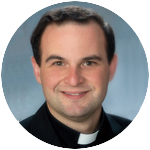
Father Eric J. Banecker
Ask any realtor or interior decorator – or better yet, drive by any neighborhood – and you will discover that grey is a very popular color right now. Homes, walls, clothes: grey is everywhere. I have no idea how such trends start. Clever marketing and peer pressure certainly help. But I also think it bespeaks a deeper cultural trend.
I recently saw an image of the stained-glass windows at Sainte-Chappelle in Paris. They are the opposite of grey. The brilliant colors and lively images portray vivaciousness, light, and order. Grey is the color of sameness and conformity, it’s sort of the lowest common denominator of colors. (Those who – like me – read the novel “The Giver” as part of middle school curriculum know that it isn’t until toward the end of the book that the reader realizes a crucial fact: in the dystopian world of the novel, there are no colors.)
This is what our contemporary age does, I fear. It sucks the energy out of life and boils it down to easily-purchasable units. Everything – even the human person itself – becomes a commodity to be purchased. Capitalist society imbues everything with a transactional quality. We all contribute to it in one way or another.
[hotblock]
I once had a college professor – a man I admired very much, even as we saw the world very differently – who chided our class for being so conservative, in the sense that the questions we asked had more to do with getting the answer “right” on the test than truly learning. We had internalized, he said, a vision of university studies which saw it as a degree factory, a chance to obtain the necessary credentials for monetary success and social mobility.
Now, at the time I saw such a vision as preferential to one influenced by 1960s-era student radicalism, which he seemed to have a sympathy to. And yet as I look back, I realize that, as Patrick Deneen points out, they are actually two sides of the same coin. The triumph of unfettered capitalism depends upon a certain rejection of traditional moral codes, and that cultural upheaval in term feeds into more economic liberalization.
For Catholics, then, I believe we have a duty in the midst of our grey cultural wasteland to present anew the vision of Sainte-Chappelle. Theirs was the way of creativity, dynamism, careful craftsmanship, and solidarity. It means saying yes to the nuclear family, and also the wider clan and village, along with wider networks which even stretch across vast distances.
I had a lively conversation recently with some wonderful couples, and we were discussing (half in jest) Philadelphia’s renowned parochial and insular culture. And while I value openness to the world and its cultures, I also have to agree with former British PM Theresa May, that if you are a citizen of everywhere, you are a citizen of nowhere.
Indeed Brexit, the U.S. southern border crisis, and even the reckoning about policing in America all have to do with balancing openness to the wide world with the stated desire and right of a community to prevent harmful interference from those seen as outsiders. This, of course, does not give us permission to demonize the other or care only about my carefully selected “group.”
But rootedness and stability are necessary for a healthy life. Limits, a robust sense of community, not to mention care for our common home, all fly in the face of the glitz and glamour of Vegas, the jet-setting lifestyle of globalists, and the vapidness of left-progressivism.
Sainte-Chappelle is a product of its era, a time we now call the Middle Ages. It is an age derided by many, idealized by others, and understood by a few. But from the artifacts it has left us, we can see that it was a time open to the world with its newly (re-)discovered Greek learning and Arabic mathematics, yet ordered and settled at the same time.
Of course, time moves in only one direction: forward. We cannot go back to 1215. But neither can we jettison the mark it left on the church and the world. It seems to me that with so many people silently drifting away from faith, the liveliness and vigor of a robust Catholicism can be very attractive.
In these past few months, many people have been slowly questioning their place in the world. And in the crucible of hardship and loneliness exacerbated by the pandemic, some have given faith in Jesus Christ a fresh look.
Our grey world needs wonder, beauty, and truth. It needs, if not Sainte-Chappelle exactly, faith in a crucified-yet-risen Messiah which inspired its builders and which truly brings light and color to our world.
***
Father Eric J. Banecker is parochial administrator of St. Francis de Sales Parish, Philadelphia.
PREVIOUS: Pandemic reminds us we are made for loving relationship
NEXT: Sharing abundantly, without holding back



Share this story